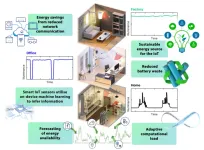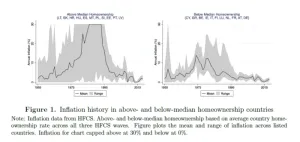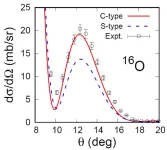(Press-News.org) We are often attracted to others with whom we share an interest, but that attraction may be based on an erroneous belief that such shared interests reflect a deeper and more fundamental similarity—we share an essence—according to research published by the American Psychological Association.
“Our attraction to people who share our attributes is aided by the belief that those shared attributes are driven by something deep within us: one’s essence,” said lead author Charles Chu, PhD, an assistant professor at the Boston University Questrom School of Business. “To put it concretely, we like someone who agrees with us on a political issue, shares our music preferences, or simply laughs at the same thing as us not purely because of those similarities, but because those similarities suggest something more—this person is, in essence, like me, and as such, they share my views of the world at large.”
This thought process is driven by a type of psychological essentialism that is applied specifically to people’s ideas about the self and individual identity, according to Chu, adding that people “essentialize” many things—from biological categories such as animal species to social groups such as race and gender—and do so in virtually all human cultures.
“To essentialize something is to define it by a set of deeply rooted and unchanging properties, or an essence,” said Chu. “For example, the category of ‘wolf’ is defined by a wolf essence, residing in all wolves, from which stems attributes such as their pointy noses, sharp teeth and fluffy tails as well as their pack nature and aggressiveness. It is unchanging in that a wolf raised by sheep is still a wolf and will eventually develop wolf-like attributes.”
Recently, researchers have begun to focus on the category of the self and have found that just as we essentialize other categories, we essentialize the self, according to Chu.
“To essentialize me is to define who I am by a set of entrenched and unchanging properties, and we all, especially in Western societies, do this to some extent. A self-essentialist then would believe that what others can see about us and the way we behave are caused by such an unchanging essence,” he said.
To better understand how self-essentialism drives attraction between individuals, researchers conducted a series of four experiments. The research was published in the Journal of Personality and Social Psychology.
In one experiment, 954 participants were asked their position on one of five randomly assigned social issues (abortion, capital punishment, gun ownership, animal testing, or physician-assisted suicide). Half the participants then read about another individual who agreed with their position, while the other half read about an individual who disagreed with their position. All participants then completed a questionnaire on how much they believed they shared a general view of the world with the fictitious individual, their level of interpersonal attraction to that person and their overall beliefs in self-essentialism.
Researchers found that participants who scored high on self-essentialism were more likely to express an attraction to the fictitious individual who agreed with their position and to report a shared general perception of reality with that individual.
A similar experiment involving 464 participants found the same results for a shared attribute as simple as the participants’ propensity to overestimate or underestimate a number of colored dots on a series of computer slides. In other words, the belief in an essential self led people to assume that just a single dimension of similarity was indicative of seeing the entire world in the same way, which led to more attraction.
In another experiment, 423 participants were shown eight pairs of paintings and asked which in each pair they preferred. Based on their responses, participants were identified as either a fan of the Swiss-German artist Paul Klee or the Russian painter Wassily Kandinsky. Half of each fan group was then told that artistic preference was part of their essence; the other half was told it had no connection. All were then exposed to two hypothetical individuals, one of whom had the same artistic preference and one who differed. Participants who were told that artistic preference was connected to their essence were significantly more likely to express an attraction to a hypothetical person with the same artistic preferences than those who were told artistic preference had nothing to do with their essence.
A final experiment categorized 449 participants as fans of one of the two artists and then presented them with information about whether using one’s own essence was useful or not in perceiving other people. This time, one-third of the participants were told that essentialist thinking could lead to inaccurate impressions of others, one-third were told that essentialist thinking could lead to accurate impressions of others and the final third were given no information.
As expected, researchers found participants who were told that essentialist thinking could lead to accurate impressions of others were more likely to report attraction to and shared reality with hypothetical individuals with similar art preferences.
Chu said he was most surprised to find that something as minimal as a shared preference for an artist would lead people to perceive that another individual would see the world the same way as they do. Self-essentialist thinking, though, could be a mixed blessing, he warned.
“I think any time when we’re making quick judgments or first impressions with very little information, we are likely to be affected by self-essentialist reasoning,” said Chu. “People are so much more complex than we often give them credit for, and we should be wary of the unwarranted assumptions we make based on this type of thinking.”
Article: “Self-Essentialist Reasoning Underlies the Similarity-Attraction Effect,” by Charles Chu, PhD, Boston University School of Management, and Brian Lowery, PhD, Stanford University. Journal of Personality and Social Psychology, published online April 13, 2023.
Contact: Charles Chu, PhD, can be reached via email at c55chu@bu.edu.
END
Some people may be attracted to others over minimal similarities
Be wary of unwarranted assumptions, researcher warns
2023-04-13
ELSE PRESS RELEASES FROM THIS DATE:
The Biophysical Journal launches Postdoctoral Reviewer Program
2023-04-13
Today the Biophysical Journal is launching a new initiative, the Postdoctoral Reviewer Program. The program provides postdoctoral researchers in biophysics the opportunity to partner with Associate Editors and complete reviews that will be used in deciding whether articles will be accepted for publication.
Candidates for this program must be in a postdoctoral position during the 2023–2024 academic year and a member of BPS in good standing. Applications for the new program will be accepted through July 1 for a single-year term beginning in September 2023. Interested candidates can find more information about the program and application process online.
“I am extremely ...
Scientists create high-efficiency sustainable solar cells for IoT devices with AI-powered energy management
2023-04-13
Newcastle University researchers have created environmentally-friendly, high-efficiency photovoltaic cells that harness ambient light to power internet of Things (IoT) devices.
Led by Dr Marina Freitag, the research group from the from School of Natural and Environmental Sciences (SNES) created dye-sensitized photovoltaic cells based on a copper(II/I) electrolyte, achieving an unprecedented power conversion efficiency of 38% and 1.0V open-circuit voltage at 1,000 lux (fluorescent lamp). The cells are non-toxic and environmentally friendly, setting a new standard for sustainable ...
A sharper look at the M87 black hole
2023-04-13
The iconic image of the supermassive black hole at the center of M87—sometimes referred to as the “fuzzy, orange donut”—has gotten its first official makeover with the help of machine learning. The new image further exposes a central region that is larger and darker, surrounded by the bright accreting gas shaped like a “skinny donut.” The team used the data obtained by the Event Horizon Telescope (EHT) collaboration in 2017 and achieved, for the first time, the full resolution of the array.
In 2017, the EHT collaboration used a network of seven pre-existing telescopes ...
Gentle method allows for eco-friendly recycling of solar cells
2023-04-13
By using a new method, precious metals can be efficiently recovered from thin-film solar cells. This is shown by new research from Chalmers University of Technology, Sweden. The method is also more environmentally friendly than previous methods of recycling and paves the way for more flexible and highly efficient solar cells.
Today there are two mainstream types of solar cells. The most common is silicon-based and accounts for 90 percent of the market. The other type is called thin-film solar cells which in turn uses three main sub-technologies, one of which is known as CIGS ...
Infant formulas promise too much
2023-04-13
Many infant formulas promise a lot. Several products claim that they help develop the brain, increase immunity and promote children's growth and development, among other things.
Now a research group led by Imperial College London has looked at whether these promises have any substance to them. The article has recently been published in BMJ.
“Most of the claims about the health-giving and nutritional properties of breast milk substitutes seem to be based on little or no evidence,” the research group says.
Claims surrounding these replacement milk products are controversial. They can give the impression ...
CESJ selected for the ERC grant to launch a European program of science journalists in residence
2023-04-13
Milan (Italy), 13 April 2023 – The Center for Ethics in Science and Science Journalism (CESJ, www.cesj.eu) is among the partners of the FRONTIERS consortium that was selected by the European Research Council for a grant of 1.5 million euro to establish a residency program for science journalists in research institutions across Europe, and measure its impact on the lifelong professional development of science journalism in Europe. The consortium also includes the NOVA University of Lisbon (Portugal), ...
Living through high inflation increases home ownership
2023-04-13
People who experience periods of high inflation are more likely to buy a home, according to a new study from the University of California San Diego’s Rady School of Management.
The paper, to be published in The Journal of Finance, uses various sources of data which reveal households that have been exposed to high inflation are more likely to invest in real estate. The study suggests many homeowners buy because they are motivated to protect themselves from possible future price hikes.
The study is the first to reveal that personal ...
Eastern wolves evolved separately from grey wolves
2023-04-13
A new paper in Molecular Biology and Evolution, published by Oxford University Press, provides interesting new evidence about the evolution of North American wolves, which has been a subject of debate among conservationists and taxonomists.
Southeastern Canada is home to populations of wolves and coyotes whose origins and genetic relationships have long puzzled scientists. In particular, eastern wolves have been the subject of great dispute, and it remains unknown whether these canids represent ...
Visualizing differences in nuclear structure
2023-04-13
Helium usually has two protons and two neutrons strongly bound to each other, often forming a substructure within the nucleus. A nucleus composed of several such substructures is called a cluster structure. In the standard picture, nuclei are difficult to understand in terms of so-called shell structure; because there was no way to clearly distinguish whether each nucleus has a cluster or a shell structure.
Associate Professor Wataru Horiuchi and Professor Naoyuki Itagaki from the Osaka Metropolitan University Graduate School of Science, have developed an ...
The Lancet Neurology: Identifying ‘hallmark’ Parkinson’s disease protein build-up could aid early detection and pave way for improved diagnosis and treatment
2023-04-13
Cross-sectional study of 1,123 participants confirms α-synuclein seed amplification assay (αSyn-SAA) technique is highly accurate at identifying people with Parkinson’s disease.
The technique detects at-risk individuals and those with early, non-motor symptoms of Parkinson’s disease prior to diagnosis, suggesting that a positive result on αSyn-SAA may be an early indicator of disease onset.
Differences in the frequency of a positive αSyn-SAA result were detected based on age and sex, and if people ...
LAST 30 PRESS RELEASES:
A JBNU–KIMS collaborative study on a cost-effective alloy matches superalloys for power plants and energy infrastructure
New study overturns long-held model of how plants coordinate immune responses.
New AI model predicts disease risk while you sleep
Scientists discover molecular ‘reshuffle’ and crack an 80-year-old conundrum
How stressors during pregnancy impact the developing fetal brain
Electrons lag behind the nucleus
From fungi to brain cells: one scientist's winding path reveals how epigenomics shapes neural destiny
Schizophrenia and osteoporosis share 195 genetic loci, highlighting unexpected biological bridges between brain and bone
Schizophrenia-linked genetic variant renders key brain receptor completely unresponsive to both natural and therapeutic compounds
Innovative review reveals overlooked complexity in cellular energy sensor's dual roles in Alzheimer's disease
Autism research reframed: Why heterogeneity is the data, not the noise
Brazil's genetic treasure trove: supercentenarians reveal secrets of extreme human longevity
The (metabolic) cost of life
CFRI special issue call for papers: New Frontiers in Sustainable Finance
HKU Engineering scholar demonstrates the smallest all-printed infrared photodetectors to date
Precision empowerment for brain "eavesdropping": CAS team develops triple-electrode integrated functional electrode for simultaneous monitoring of neural signals and chemical transmitters during sleep
Single-capillary endothelial dysfunction resolved by optoacoustic mesoscopy
HKU three research projects named among ‘Top 10 Innovation & Technology News in Hong Kong 2025’ showcasing excellence in research and technology transfer
NLRSeek: A reannotation-based pipeline for mining missing NLR genes in sequenced genomes
A strand and whole genome duplication–aware collinear gene identification tool
Light storage in light cages: A revolutionary approach to on-chip quantum memories
Point spread function decoupling in computational fluorescence microscopy
BacPhase: Long-insert paired-end sequencing for bin marker construction and genome phasing
GmWOX1 regulates the mediolateral polarity of compound leaves in soybean
ChargeFabrica: An open-source simulation tool that aims to accelerate search for high performance perovskite solar cells
High levels of ADAR overexpression induce abundant and stochastic off-target RNA editing in rice protoplasts
On-demand upgraded recycling of polyethylene and construction of sustainable multifunctional materials based on the "LEGO" strategy
New "Stomata in-sight" system allows scientists to watch plants breathe in real-time
Anorexia nervosa may result in long-term skeletal muscle impairment
Narrative-based performance reviews deemed fairest by employees
[Press-News.org] Some people may be attracted to others over minimal similaritiesBe wary of unwarranted assumptions, researcher warns





